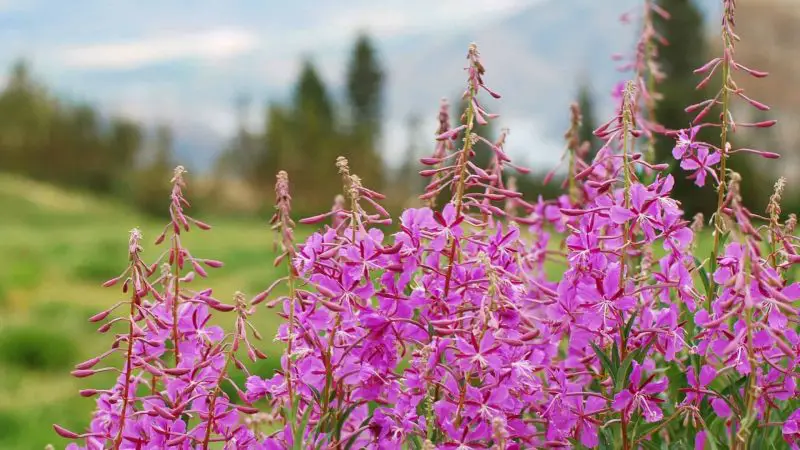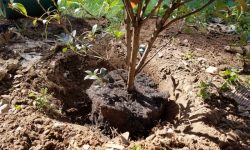Fireweed is a striking wildflower celebrated for its tall, vibrant spikes of magenta blooms. Known for its ability to thrive in disturbed or recently burned areas, it quickly transforms landscapes with bursts of color. Beyond its visual appeal, fireweed plays an essential role in supporting local ecosystems, providing nectar for bees, butterflies, and other pollinators. Gardeners and nature enthusiasts appreciate its resilience, adaptability, and ability to establish itself with minimal care. Observing its growth patterns and bloom cycles offers valuable insights for cultivating this remarkable plant.
Understanding where fireweed grows naturally and how to replicate those conditions in gardens ensures optimal results. Its tolerance for varying soils, climates, and light conditions makes it an excellent choice for both naturalized landscapes and ornamental settings. With proper care, fireweed not only enhances aesthetics but also contributes to biodiversity, soil stabilization, and seasonal ecological balance, making it a rewarding addition to any garden or restoration project.
Fireweed’s Natural Distribution

Fireweed is native to temperate regions of the Northern Hemisphere. It commonly occurs in North America, Europe, and parts of Asia. In North America, it is abundant across Canada, Alaska, and northern United States. Its range extends southward along mountain ranges, often favoring higher altitudes with cooler climates.
The plant typically colonizes disturbed areas. Wildfires, landslides, and human activity create open spaces where fireweed can quickly establish. Its seeds are lightweight and easily dispersed by wind, allowing rapid colonization of exposed soils. This characteristic makes fireweed a pioneer species, promoting ecological recovery after disturbances.
Its distribution is influenced by regional climate and soil conditions. Fireweed thrives in well-drained, nutrient-rich soils but tolerates poorer substrates when competition is minimal. Seasonal temperature fluctuations and sufficient rainfall further support robust growth. Understanding these distribution patterns helps gardeners select appropriate locations for planting while supporting natural populations in conservation efforts.
Environmental Factors Influencing Growth
Climate and Temperature
Fireweed is highly sensitive to local climate conditions, which directly affect its growth and flowering potential. Areas with moderate summer temperatures and adequate rainfall encourage lush foliage and vibrant blooms. Conversely, regions experiencing prolonged heat or drought may see stunted growth and fewer flowers. The plant’s adaptation to temperate and subarctic zones allows it to flourish where other species might struggle, making it a resilient choice for naturalized landscapes.
Temperature also plays a critical role in the timing of flowering. Northern populations often bloom later due to shorter growing seasons, while plants at lower elevations or in southern regions may flower earlier. Sudden frost or unexpected cold snaps can damage emerging shoots, limiting both flower quantity and plant vigor. By understanding and monitoring these climate factors, gardeners and conservationists can select optimal locations, ensuring healthy growth, abundant blooms, and sustainable fireweed populations for both aesthetic and ecological purposes.
Soil and Moisture Requirements
Fireweed thrives in soils that are loose, well-drained, and moderately fertile. Sandy loam, gravelly, or slightly acidic soils closely resemble its natural habitat, promoting robust root systems and healthy plant structure. Heavy clay or compacted soils can restrict root growth, trap water, and increase the risk of root diseases, ultimately reducing flowering success. Gardeners should ensure proper soil preparation before planting to create optimal conditions for establishment and long-term growth.
Consistent soil moisture is equally important. While fireweed is somewhat drought-tolerant once established, young plants require regular water to develop strong roots and vibrant blooms. Overly dry conditions can stunt growth, delay flowering, and weaken resilience to environmental stress. Conversely, waterlogged soils can suffocate roots and encourage fungal infections. Maintaining balanced moisture through natural rainfall or supplemental irrigation supports steady growth, enhances flowering, and ensures the plant thrives both in gardens and wild settings. Healthy soil and adequate water also benefit pollinators, improving ecosystem health around fireweed patches.
Sunlight Exposure
Fireweed thrives in full sunlight, which is crucial for its vigorous growth and abundant blooms. The plant requires at least six hours of direct sunlight daily to develop strong stems, rich green foliage, and dense flowering clusters. In areas with limited light, fireweed may grow tall and spindly, producing fewer flowers and weaker stems. Adequate sunlight ensures efficient photosynthesis, providing the energy needed for root development and perennial regrowth. Gardeners who replicate natural sun exposure often notice healthier plants with prolonged blooming periods, as energy stores accumulate in the roots for the next season.
Sunlight intensity also influences stress tolerance and overall plant health. In hotter climates, partial shade during the peak afternoon hours can protect leaves from scorching while still allowing sufficient light for flowering. Observing fireweed in its native habitats helps gardeners and landscapers determine optimal light conditions for cultivation. Proper sunlight management enhances flower vibrancy, supports pollinators, and ensures long-term survival. By balancing sun exposure with protection from extreme heat, fireweed can achieve both ecological and ornamental benefits, thriving consistently across various locations.
Fireweed Blooming by Region
Northern Regions
In northern regions, including Alaska, Canada, and the northern United States, fireweed thrives in cool climates and long summer daylight. Blooming typically occurs from mid-summer to early fall, depending on latitude and altitude. These areas provide well-drained soils and open spaces, often following wildfires or natural disturbances. Extended daylight supports rapid growth, allowing plants to develop strong stems, vibrant flowers, and abundant seed production.
Fireweed in these regions plays a vital ecological role. It provides nectar for late-season pollinators such as bees and butterflies, which rely on these blooms to build energy reserves before winter. Gardeners mimic these conditions by ensuring full sun exposure and proper soil moisture. Attention to frost dates and local climate ensures successful establishment. Observing regional flowering patterns helps plan conservation projects and ornamental gardens, promoting both ecological and aesthetic benefits. Northern fireweed populations also contribute to soil stabilization, particularly in disturbed habitats, enhancing ecosystem recovery.
Southern Regions
In southern regions, such as the Appalachian Mountains and parts of the Pacific Northwest, fireweed grows under warmer temperatures and shorter summer days. Blooming often begins earlier than in northern areas, typically in early to mid-summer. Soil fertility, moisture availability, and sunlight exposure directly influence flower density and plant health. Consistent irrigation in drier areas supports extended blooming periods.
Southern fireweed populations may face competition from other perennials. Selecting open spaces, disturbed sites, or well-prepared garden beds enhances growth. Mulching helps retain soil moisture and regulates temperature, while nutrient-rich soils improve flower production. Gardeners benefit from understanding local climate patterns and planning planting schedules to ensure continuous blooms. Managed properly, fireweed thrives reliably, offering vibrant floral displays and supporting pollinators in these warmer, southern habitats.
Coastal and Mountain Areas
Coastal and mountainous regions offer complex microclimates that strongly influence fireweed growth and reproduction. The combination of wind exposure, fog, and variable rainfall creates fluctuating soil moisture levels, which fireweed tolerates well due to its adaptable root system. High humidity in coastal zones helps maintain leaf turgor and encourages robust flowering, while well-drained slopes prevent waterlogging, reducing the risk of root rot. In mountainous areas, the cooler temperatures at higher elevations often delay flowering, creating a staggered bloom that extends the availability of nectar for pollinators.
Fireweed in these environments not only stabilizes soil on slopes but also enhances local ecosystems by attracting bees, butterflies, and other beneficial insects. Coastal populations benefit from mineral-rich soils, which promote denser and more vibrant flower clusters. Gardeners and land managers can leverage these traits to restore disturbed landscapes or support pollinator habitats effectively. By understanding the specific microclimate conditions—such as wind patterns, temperature variation, and humidity—planting strategies can be tailored. This ensures fireweed thrives sustainably, contributing to ecological balance, erosion control, and seasonal floral beauty in both wild and cultivated settings.
Pollinator Benefits and Wildlife Importance
Attracting Bees and Butterflies
Fireweed serves as a vital resource for a wide range of pollinators due to its long blooming period and nectar-rich flowers. Beyond bees and butterflies, hummingbirds and certain moth species are also attracted to its vibrant pink to purple blooms. These visitors contribute to cross-pollination, enhancing genetic diversity and seed viability. In natural and garden settings, fireweed helps maintain healthy pollinator populations, supporting broader ecosystem stability.
The plant’s dense flower spikes provide a continuous nectar supply over several weeks, which is especially important during late summer and early fall when other blooms decline. This ensures pollinators have adequate energy reserves for overwintering or migration. Gardeners can maximize fireweed’s ecological impact by planting it in sunny, open areas with well-drained soil, while reducing chemical interventions that might harm visiting insects. Encouraging fireweed growth in corridors or near other flowering plants creates interconnected habitats, promoting biodiversity. Its combination of beauty and ecological function makes fireweed an indispensable component for sustaining pollinator health and overall environmental balance.
Supporting Birds and Small Mammals
Fireweed provides critical resources for birds and small mammals throughout its growing season. Its seeds are high in nutrients, sustaining finches, sparrows, and other granivorous birds during late summer and early fall when food becomes scarcer. Small mammals, including rabbits and ground squirrels, use the plant for cover, nesting protection, and occasional foraging. This dual functionality enhances local biodiversity and contributes to a balanced ecosystem.
Beyond direct nourishment, fireweed increases habitat complexity, creating microenvironments that support shelter and breeding opportunities. Birds feeding on seeds may inadvertently aid in seed dispersal for fireweed and neighboring plant species, promoting natural regeneration. Gardeners and conservationists often incorporate fireweed in meadows, riparian zones, or reclamation areas to encourage wildlife presence. Its combination of vibrant blooms for pollinators and seeds for birds and mammals underscores its ecological versatility. Planting fireweed thoughtfully ensures long-term benefits for wildlife, ecosystem health, and landscape resilience, making it an essential component of sustainable gardening and restoration efforts.
Caring for Fireweed: Tips for Thriving Growth
Watering Requirements
Fireweed benefits from consistent soil moisture, particularly during its early growth stages. Newly planted seedlings require frequent watering to establish a robust root system capable of supporting tall stems and abundant flowers. Watering should be deep but infrequent, encouraging roots to grow downward rather than staying near the surface. Overly saturated soils can cause root rot and increase susceptibility to fungal infections, so monitoring soil drainage is essential.
In natural environments, fireweed thrives along stream banks, wetlands, and moist meadows, indicating its preference for damp conditions without standing water. In cultivated gardens, applying water in the morning helps foliage dry during daylight, minimizing disease risks. Mulching around the base not only retains moisture but also moderates soil temperature, enhancing plant resilience. Consistent yet balanced watering practices contribute to vigorous growth, prolonged flowering, and overall plant health, ensuring that fireweed remains an attractive and ecologically beneficial component of gardens or restoration sites.
Fertilization Practices
Fireweed benefits from moderate soil fertility, and careful nutrient management can enhance its growth without causing imbalance. Incorporating organic matter, such as compost or aged manure, improves soil structure, promotes beneficial microbial activity, and provides essential nutrients. Applying a light, balanced fertilizer in early spring encourages strong shoots and abundant flowering, setting the stage for a vibrant bloom season. Gardeners should focus on providing steady nutrition rather than high doses, as excessive fertilizers can disrupt natural growth patterns.
Over-fertilization, particularly with high-nitrogen products, can result in excessive leafy growth and weaker flowers, reducing the plant’s visual appeal and ecological benefits. Slow-release or balanced fertilizers supply nutrients gradually, supporting consistent growth while minimizing nutrient runoff. Observing plant health and soil condition allows for timely adjustments to fertilization practices. By maintaining optimal nutrient levels, gardeners ensure fireweed develops robust stems, dense flower clusters, and long-lasting blooms, while also sustaining soil fertility and ecosystem health. Thoughtful fertilization enhances both aesthetic and environmental value.
Pruning and Maintenance
Pruning fireweed at the right time ensures both aesthetic appeal and plant health. Regularly removing spent blooms not only stimulates new flowering but also prevents the plant from producing excessive seeds that could lead to uncontrolled spreading. By focusing the plant’s energy on active growth, gardeners encourage stronger stems, denser foliage, and vibrant flower clusters throughout the blooming season. Additionally, trimming damaged or diseased stems enhances airflow within the plant canopy, lowering the risk of fungal infections and other common plant ailments.
Seasonal maintenance, such as cutting back the plant in late fall or early spring, prepares fireweed for renewed growth. This practice promotes robust root systems, helping the plant survive harsh conditions while supporting long-term vitality. Combining careful pruning with consistent watering, soil enrichment, and sunlight management creates an environment where fireweed thrives naturally. Maintaining these routines ensures a balanced, visually appealing display that also provides ecological benefits, including habitat for pollinators and seed-dispersing birds. Thoughtful maintenance reinforces both the beauty and resilience of fireweed in cultivated landscapes.
Common Mistakes and Troubleshooting Fireweed Growth
Overwatering Issues
Overwatering fireweed can significantly impact its health and longevity. While the plant appreciates consistent moisture, excessive water creates anaerobic soil conditions that suffocate roots. Prolonged wetness encourages fungal infections, root rot, and other pathogens, which may stunt growth or kill the plant entirely. Ensuring that soil drains well and avoids puddling is crucial for establishing a robust root system capable of supporting tall stems and vibrant flowers.
Gardeners should assess soil moisture regularly instead of following a rigid watering schedule. Mulching around the base retains adequate moisture during dry periods while preventing oversaturation during rainy spells. Adjusting irrigation based on weather, soil type, and plant maturity promotes healthy growth and reduces disease incidence. Observing leaf turgor, color, and flowering patterns provides cues for appropriate watering. By maintaining balanced soil moisture, fireweed thrives naturally, offering consistent blooms and supporting pollinators while minimizing water-related challenges in both garden and restoration settings.
Ignoring Spacing
Ignoring proper spacing when planting fireweed can severely affect plant health and garden aesthetics. Crowded plants compete for light, nutrients, and water, resulting in weak, elongated stems and smaller, less vibrant blooms. Limited airflow among closely packed plants creates a humid microenvironment, increasing the risk of fungal infections, mildew, and other diseases. Overcrowding also reduces pollinator access, which can negatively impact seed production and overall reproductive success.
To avoid these problems, gardeners should plan adequate spacing between fireweed plants, typically allowing each plant room to expand both roots and foliage. Thinning seedlings and carefully arranging new plantings ensures each individual receives sufficient sunlight and nutrients. Proper spacing promotes stronger stems, fuller flower displays, and healthier foliage while supporting natural pollination and ecological benefits. By paying attention to plant layout, gardeners maintain an attractive, resilient fireweed population that thrives year after year while minimizing disease risk and optimizing growth conditions.
Poor Soil Preparation
Poor soil preparation can significantly hinder fireweed development. Planting directly into compacted or nutrient-deficient soil limits root expansion, reduces water retention, and stunts growth. Fireweed thrives in loose, well-draining soils rich in organic matter, allowing roots to establish quickly and efficiently. Ignoring soil quality may result in weak stems, sparse blooms, and increased susceptibility to disease.
Improving soil before planting is essential for long-term success. Incorporating compost, aged manure, or other organic amendments enriches nutrient content and enhances soil structure. Testing soil pH and making adjustments ensures optimal nutrient availability for fireweed. Proper preparation also improves moisture retention while preventing waterlogging, creating a balanced environment for healthy root and shoot development. By investing time in soil improvement, gardeners support vigorous growth, lush foliage, and abundant flowering, ensuring fireweed thrives season after season.
Propagation Techniques
Division of Mature Plants
Dividing mature fireweed is an effective propagation technique for both home gardens and restoration projects. Carefully dig up the established plant, taking care not to damage the root system. Separate the root mass into sections, ensuring that each division has healthy roots and at least one vigorous stem. Proper handling during this process minimizes transplant shock and promotes successful reestablishment in new locations.
Once divided, replant each section in well-prepared, loose, and fertile soil. Water thoroughly to help roots settle and provide partial shade if needed during the first few weeks. Divisions allow gardeners to expand fireweed populations efficiently while preserving the parent plant’s vigor and flowering potential. Regular monitoring after planting ensures strong growth, abundant blooms, and long-term garden success. This method also encourages genetic consistency, maintaining the desirable traits of the original plants across new sites.
Root Cuttings
Root cuttings provide an efficient method to propagate fireweed, particularly during its dormant season when above-ground growth is minimal. Choose thick, healthy roots from a mature plant, and cut them into sections approximately 2 to 4 inches long. Plant these cuttings horizontally in a well-draining, moist medium, ensuring the cut surfaces are slightly covered with soil to encourage root and shoot development. This method allows gardeners to expand their fireweed population while maintaining the genetic traits of the parent plant.
After planting, it is important to keep the soil consistently damp but not waterlogged. Excess moisture can cause rotting, while too little may prevent sprouting. Root cuttings typically take several weeks to produce shoots, depending on temperature and soil conditions. Once new growth emerges, gradually acclimate the young plants to outdoor conditions and sunlight. This controlled approach ensures strong, healthy fireweed plants, making root cuttings a reliable technique for both home gardeners and ecological restoration projects seeking uniform, vigorous specimens.
Seasonal Care and Maintenance
Spring Preparation
Summer Monitoring
Summer monitoring is crucial to ensure fireweed thrives throughout its peak growing season. Gardeners should regularly inspect plants for signs of stress, including wilting, yellowing leaves, or weak stems, which may indicate insufficient water, nutrient deficiencies, or pest activity. Maintaining consistent soil moisture is vital, as drought can reduce flower production and overall plant vigor. However, overwatering should be avoided to prevent root rot or fungal infections. Early detection of disease or insect infestations allows timely interventions, preserving plant health and sustaining a vibrant garden display.
In addition to observation, practical summer care supports long-term vitality. Mulching around the base of fireweed conserves soil moisture, regulates temperature, and suppresses weed growth, minimizing competition for resources. Deadheading spent blooms encourages the plant to produce additional flowers, extending the blooming period and enhancing visual appeal. Regular pruning of damaged or diseased stems further improves airflow and reduces susceptibility to pathogens. By combining monitoring with proactive care, gardeners ensure fireweed maintains strength, beauty, and reproductive success throughout the summer months.
Fall and Winter Preparation
Fall and winter preparation is essential for maintaining healthy fireweed populations. As the growing season ends, gardeners should carefully remove dead leaves, spent flowers, and weak stems. This cleanup minimizes disease risk and prevents pests from overwintering in plant debris. Gradually reducing watering allows the plant to enter dormancy naturally, conserving energy and preparing it for the stress of colder months. Attention to structural maintenance, such as trimming overly tall or brittle stems, prevents damage from snow, ice, or strong winter winds, protecting the integrity of the plant for the next season.
Mulching provides critical insulation for fireweed roots during freezing temperatures. A light layer of organic mulch, such as straw or shredded leaves, stabilizes soil temperature and retains moisture without encouraging unwanted growth. Avoiding late-season fertilization is important, as nutrient uptake can trigger tender growth that is susceptible to frost damage. By following these seasonal care practices, gardeners ensure fireweed remains resilient, healthy, and ready for vigorous regrowth in spring. Proper fall and winter management supports long-term flowering, structural strength, and overall ecosystem benefits.
Troubleshooting and Recovery
Using Weak or Diseased Plants
Using weak or diseased fireweed plants for propagation can significantly compromise both establishment and long-term garden success. Unhealthy specimens often exhibit poor root systems, stunted growth, or susceptibility to pests and diseases. Propagating from such plants may result in slow development, sparse flowering, or eventual plant loss, wasting time and resources. It is essential to carefully inspect parent plants, ensuring stems are firm, roots are robust, and foliage is free from spots or discoloration. Healthy selections provide a strong foundation for vigorous new growth and abundant blooms.
Additionally, avoiding diseased plants helps prevent the spread of pathogens throughout the garden. Fungal infections, bacterial rot, or pest infestations can easily transfer from one plant to another, reducing overall plant vitality. By choosing vigorous, disease-free specimens, gardeners increase the likelihood of successful propagation, stronger root development, and enhanced flowering performance. Regular monitoring of both parent and newly propagated plants maintains long-term health, ensuring that fireweed remains a resilient and visually appealing addition to the landscape. Proper selection and care promote thriving populations for years to come.
Ignoring Environmental Conditions
Ignoring environmental conditions can severely impact fireweed growth and flowering. The plant thrives in full sun, well-drained soils, and moderate temperatures. Planting in overly shaded areas or exposing young plants to extreme heat or cold can cause stunted growth, weak stems, and reduced bloom production. Adequate attention to sunlight, temperature, and soil moisture ensures that fireweed develops robust roots and strong foliage. Gardeners who neglect these factors risk poor establishment, increased susceptibility to pests, and diminished aesthetic appeal.
Additionally, managing microclimates can greatly enhance survival and vigor. Using mulch to retain soil moisture, providing temporary shading in hot climates, or protecting young plants from frost helps maintain optimal growing conditions. Observing rainfall patterns, wind exposure, and soil drainage allows for timely interventions that prevent stress and support continuous flowering. Understanding and responding to environmental needs ensures fireweed thrives in both natural and cultivated settings. Maintaining these conditions maximizes bloom potential, strengthens plant resilience, and supports healthy ecosystems for pollinators and wildlife.
Overcrowding and Poor Spacing
Overcrowding fireweed can significantly hinder its growth and flowering potential. When plants are too close together, they compete for essential resources such as nutrients, water, and sunlight. This competition weakens individual plants, causing spindly stems, smaller flowers, and reduced overall vigor. Dense clusters also limit airflow between plants, creating humid microenvironments that encourage fungal diseases and pest infestations, further compromising plant health.
Proper spacing allows fireweed to develop strong, upright stems and achieve uniform flowering across the garden or naturalized area. By providing adequate distance, gardeners ensure that each plant accesses enough sunlight and nutrients, promoting robust growth and vibrant blooms. Spacing also facilitates easier maintenance tasks such as pruning, watering, and monitoring for pests. Planning the layout carefully, thinning seedlings when necessary, and adhering to recommended distances prevents overcrowding problems, supports plant resilience, and enhances the visual appeal of fireweed plantings. Well-spaced plants are healthier, more productive, and contribute positively to local pollinator habitats.
Wildlife and Pollinator Benefits
Attracting Bees and Butterflies
Fireweed’s vibrant pink-purple flowers act as a magnet for bees, butterflies, and other pollinators. Its abundant nectar and pollen are especially important during late summer when fewer plants are in bloom. Regular visits by these insects not only aid in fertilization and seed production but also maintain healthy fireweed populations, ensuring the species continues to thrive in natural and cultivated areas. The prolonged flowering period provides a reliable food source, which is critical for pollinators preparing for winter or long migrations.
Strategic planting enhances the impact of fireweed on local pollinator communities. Placing fireweed in sunny, open areas allows maximum visibility and accessibility for insects. Gardeners and conservationists often combine fireweed with other late-blooming flowers to create pollinator corridors, offering continuous nutrition and habitat. Reducing pesticide use, maintaining soil health, and encouraging plant diversity further strengthen pollinator populations. By attracting a variety of pollinators, fireweed not only supports ecological balance but also contributes to the success of neighboring crops and native flora, reinforcing the interconnectedness of the ecosystem.
Supporting Birds and Other Wildlife
Fireweed also provides crucial resources for birds and small mammals. Its seeds are a valuable food source for finches, sparrows, and other seed-eating birds during late summer and early fall. In addition, the dense foliage offers shelter, nesting opportunities, and protection from predators, creating microhabitats that support small wildlife populations. Rabbits, ground squirrels, and other small mammals may use fireweed patches for cover and occasional grazing, further promoting biodiversity.
Incorporating fireweed into meadows, woodland edges, or naturalized gardens increases habitat complexity and ecological stability. Birds attracted to its seeds help disperse other plant species, supporting natural regeneration. Small mammals contribute to nutrient cycling through their activities, enhancing soil fertility. By fostering these interactions, fireweed acts as a keystone species in its environment. Its dual role—supporting pollinators and providing food and shelter for birds and mammals—makes it an essential plant for sustainable landscapes, encouraging resilient, interconnected ecosystems that thrive year after year.
Common Mistakes to Avoid
Overwatering Issues
Fireweed is adapted to well-drained soils and can tolerate moderate drought. Overwatering can lead to root rot, fungal infections, and weak growth. Excess moisture may also attract pests, further compromising plant health. Gardeners should ensure soil remains moist but not waterlogged, especially during early establishment.
Proper watering schedules encourage deep root development, which supports strong stems and abundant blooms. Monitoring soil moisture and adjusting irrigation according to rainfall helps fireweed thrive naturally. Avoiding excess water is crucial for maintaining long-term plant vigor and preventing common propagation failures.
Ignoring Spacing Requirements
Crowding fireweed can limit airflow and reduce sunlight exposure, which may cause leggy growth or disease outbreaks. Proper spacing allows each plant to access nutrients, light, and water efficiently. When planting multiple fireweed specimens, leaving sufficient gaps promotes healthy root expansion and flower production.
Adequate spacing also reduces competition and encourages uniform growth. Overcrowding increases the risk of fungal infections and pest infestations. By respecting spacing requirements, gardeners ensure fireweed reaches its full aesthetic and ecological potential, supporting pollinators while creating a visually pleasing landscape.
Poor Soil Preparation
Planting fireweed in compacted or nutrient-poor soil can stunt growth and reduce flowering. Preparing the soil by loosening it and adding organic matter enhances drainage and fertility. This provides an ideal environment for roots to establish and absorb nutrients.
Healthy soil supports not only strong initial growth but also long-term resilience. Fireweed thrives in soil that is moderately fertile, slightly acidic, and well-draining. Investing time in soil preparation minimizes future problems and ensures robust flowering, contributing to both garden beauty and ecological benefits.
FAQ About Where Fireweed Grows
What type of soil does fireweed prefer?
Fireweed thrives in well-draining, slightly acidic to neutral soils. Loosened, moderately fertile soil encourages strong root development, supports healthy stems, and promotes abundant flowering. Adding organic matter improves moisture retention without waterlogging, enhancing plant resilience.
How much sunlight does fireweed need?
Fireweed grows best in full sun but tolerates partial shade. Adequate sunlight ensures robust blooms, strong stems, and dense foliage. Partial shade may reduce flowering but can help in regions with intense heat. Proper light exposure supports overall plant health.
Can fireweed grow in disturbed areas?
Yes, fireweed naturally colonizes disturbed soils, forest edges, and meadows. Its fast-growing nature allows it to establish quickly after events like fires or soil disruption. Providing minimal care, well-drained soil, and sunlight enhances survival and flowering.
How often should fireweed be watered?
Fireweed requires moderate watering, keeping soil consistently moist without waterlogging. Overwatering can lead to root rot, fungal issues, and weak growth. Regular observation and adjustment according to rainfall ensure healthy establishment and abundant blooms.
Are there common pests or diseases affecting fireweed?
Fireweed is relatively pest-resistant but may occasionally attract aphids or fungal infections in overly damp conditions. Maintaining spacing, good airflow, and proper soil drainage reduces risks. Early monitoring allows for timely intervention without chemicals.
Conclusion
Fireweed is a resilient and visually striking plant that thrives in diverse habitats. Understanding its preferred growing conditions, including soil type, sunlight, and moisture levels, ensures successful cultivation. Observing seasonal cycles and respecting spacing requirements maximizes bloom potential. Proper care, combined with awareness of common mistakes, allows gardeners to enjoy vibrant flowers year after year. Fireweed also supports pollinators and contributes to ecosystem health, making it valuable both aesthetically and ecologically. By following expert tips and maintaining attentive care, you can create flourishing fireweed displays that enhance any garden or natural landscape.






